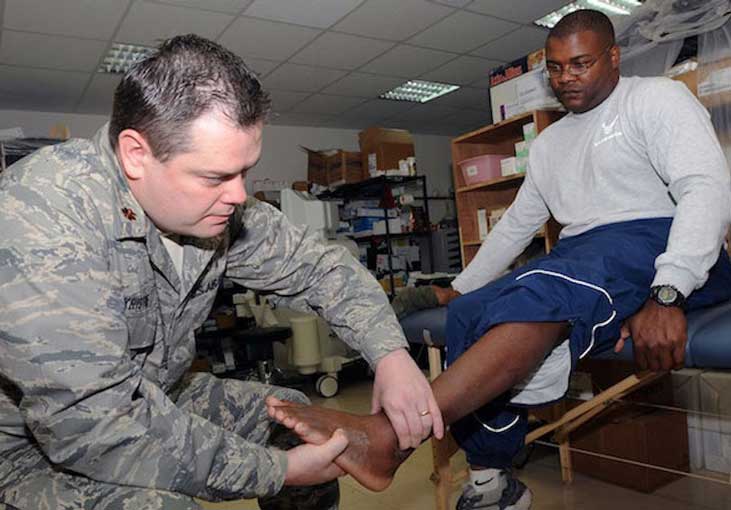Ankle sprains are common injuries that can lead to a lifetime of pain, instability, and disability if they aren’t treated properly. Ankle sprains accounted for more than 52,000 military medical visits in 2018, which is likely much less than the actual total number of ankle sprains in the military. About half of all ankle sprains don’t receive proper medical attention and rehabilitation. And up to 70% of people with ankle sprains will go on to have chronic ankle instability, a condition that causes long-term pain, instability, and disability.
When you sprain your ankle, it isn’t “just a sprain.” It’s a real injury that can have lasting consequences if it isn’t quickly and properly treated.
What is an ankle sprain?
When you sprain your ankle, you stretch or tear the ligaments that support the ankle joint. The most common ankle sprain, called a lateral or inversion ankle sprain, injures one or more of the 3 ligaments on the outside of your ankle. You can also sprain the ligaments on the inside of your ankle, called a medial or eversion ankle sprain. And you can sprain the ligament that connects the tibia (shin bone) and fibula in your lower leg, called a syndesmotic or high ankle sprain. Medial and syndesmotic ankle sprains are less common than lateral ankle sprains, but medical professionals and people who are injured often see them as more serious. In addition, they have longer recovery times.
Ankle sprains also damage the nerves that run to the ankle joint. In addition to causing pain, this also affects joint proprioception (your body’s knowledge of where the joint is positioned), your balance, and your muscle strength. When you roll your ankle, leading to a sprain, it can sometimes also fracture the bones in your ankle or foot. It’s easy to miss these fractures because they are often small and don’t always hurt as much as the sprained ligament. It’s very important to have your ankle sprain evaluated by a medical professional soon after it happens, especially if it is too painful to walk on right after the injury.
Ankle braces
Fast treatment within the first 24 hours of injury is important to your recovery. If you’re not able to put weight on your ankle within the first day, get in to see medical as soon as possible.
For the first 4–6 weeks after injury, experts recommend wearing a “functional” ankle brace, which either laces up or is secured by Velcro. These can be found at most pharmacies and grocery stores with a pharmacy section. A brace should be worn as often as possible, especially if you are going to be on your feet. Other types of support, such as elastic wraps (commonly called “ACE wraps”) or kinesiotape (the colorful tape often used by professional athletes), are not effective at protecting your ankle joint after injury. Using a brace doesn’t mean you shouldn’t see medical, though. Even if you choose to wear one, you should still have your ankle looked at.
After the first 6–8 weeks, you can reduce the time you wear the brace to when you’re being physically active—anything that involves running, jumping, or general exercise. Continue wearing the brace during activity for at least a year after your injury. Yes, it does take that long for an injury to fully heal.
Exercises for ankle sprains
Starting rehabilitation exercises within the first week after a sprain is important to ensure you fully heal and to prevent it from happening again. HPRC’s Rx3 Ankle Program has exercises that will help you on your road to recovery, especially if you have a long wait between when you see your medical provider and when you can get into physical therapy.
Ankle exercises focus on improving strength, neuromuscular control, and ankle proprioception. Balance exercises also address proprioception and can go a long way to reducing your reinjury risk.
Bottom line
People often consider ankle injuries as minor, and so ankle sprains go undertreated. This can lead to a lifetime of consequences. It’s important to seek care for an ankle injury as soon as possible to receive the best possible outcome.
